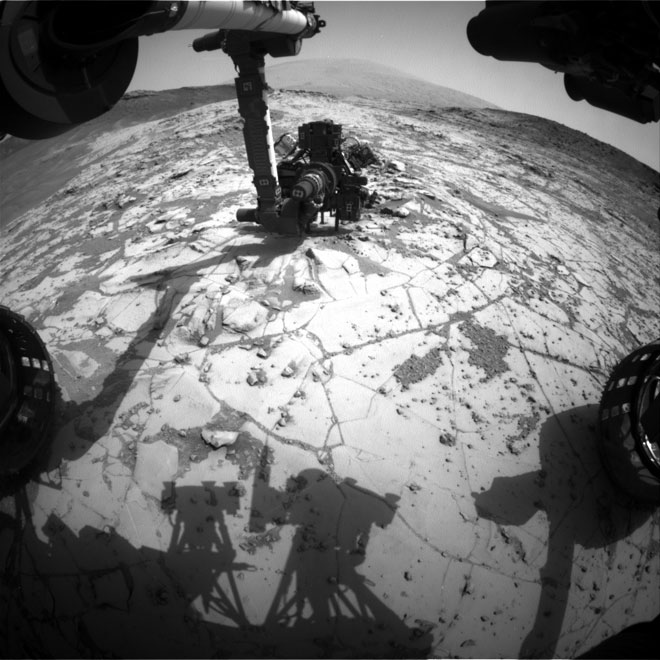
This view from the wide-angle Hazard Avoidance Camera on the front of NASA's Curiosity Mars Rover shows the rover's drill in position for a mini-drill test to assess whether a rock target called "Mojave" is appropriate for full-depth drilling to collect a sample. It was taken on Jan. 13, 2015. Photo: NASA/JPL-Caltech.
WASHINGTON (PTI): Mars rover Curiosity will drill into a crystal-rich rock to detect possible salt mineral left from a drying lake on the Red planet, according to an Indian-origin NASA scientist.
This target, called "Mojave," displays copious slender features, slightly smaller than grains of rice, that appear to be mineral crystals.
A chance to learn their composition prompted the Curiosity science team to choose Mojave as the next rock-drilling target for the 29-month-old mission investigating Mars' Gale Crater.
This week, Curiosity is beginning a "mini-drill" test to assess the rock's suitability for deeper drilling, which collects a sample for onboard laboratory analysis.
A weeklong pause in science operations to install a new version of rover flight software is scheduled to begin early next week, possibly before completion of the drilling and sample delivery.
The Mojave drilling begins Curiosity's third round of investigating the basal layer of Mount Sharp exposed at an area called "Pahrump Hills."
In the first round, the rover drove about 110 metres and scouted sites ranging about 9 metres in elevation. Then it followed a similar path, investigating selected sites in more detail.
That second pass included inspection of Mojave in November 2014 with the dust-removal brush, close-up camera and Alpha Particle X-Ray Spectrometer on the rover's arm.
The results put Mojave at the head of the list of targets for the rover's most intensive inspection, using laboratory instruments that ingest powdered rock collected by the drill.
"The crystal shapes are apparent in the earlier images of Mojave, but we don't know what they represent," said Curiosity Project Scientist Ashwin Vasavada at NASA's Jet Propulsion Laboratory, Pasadena, California.
"We're hoping that mineral identifications we get from the rover's laboratory will shed more light than we got from just the images and bulk chemistry," said Vasavada.
Curiosity's Chemistry and Mineralogy instrument, or CheMin, can identify specific minerals in rock powder from a drilled sample.
Analysis of the drill hole and drill tailings may also show whether the crystals are only at the surface, like a salty crust, or are also deeper in the rock.
"Are they salt crystals left from a drying lake? Or are they more pervasive through the rock, formed by fluids moving through the rock? In either case, a later fluid may have removed or replaced the original minerals with something else," Vasavada added.
 Previous Article
Previous Article Next Article
Next Article













The Indian Air Force, in its flight trials evaluation report submitted before the Defence Ministry l..
view articleAn insight into the Medium Multi-Role Combat Aircraft competition...
view articleSky enthusiasts can now spot the International Space Station (ISS) commanded by Indian-American astr..
view article